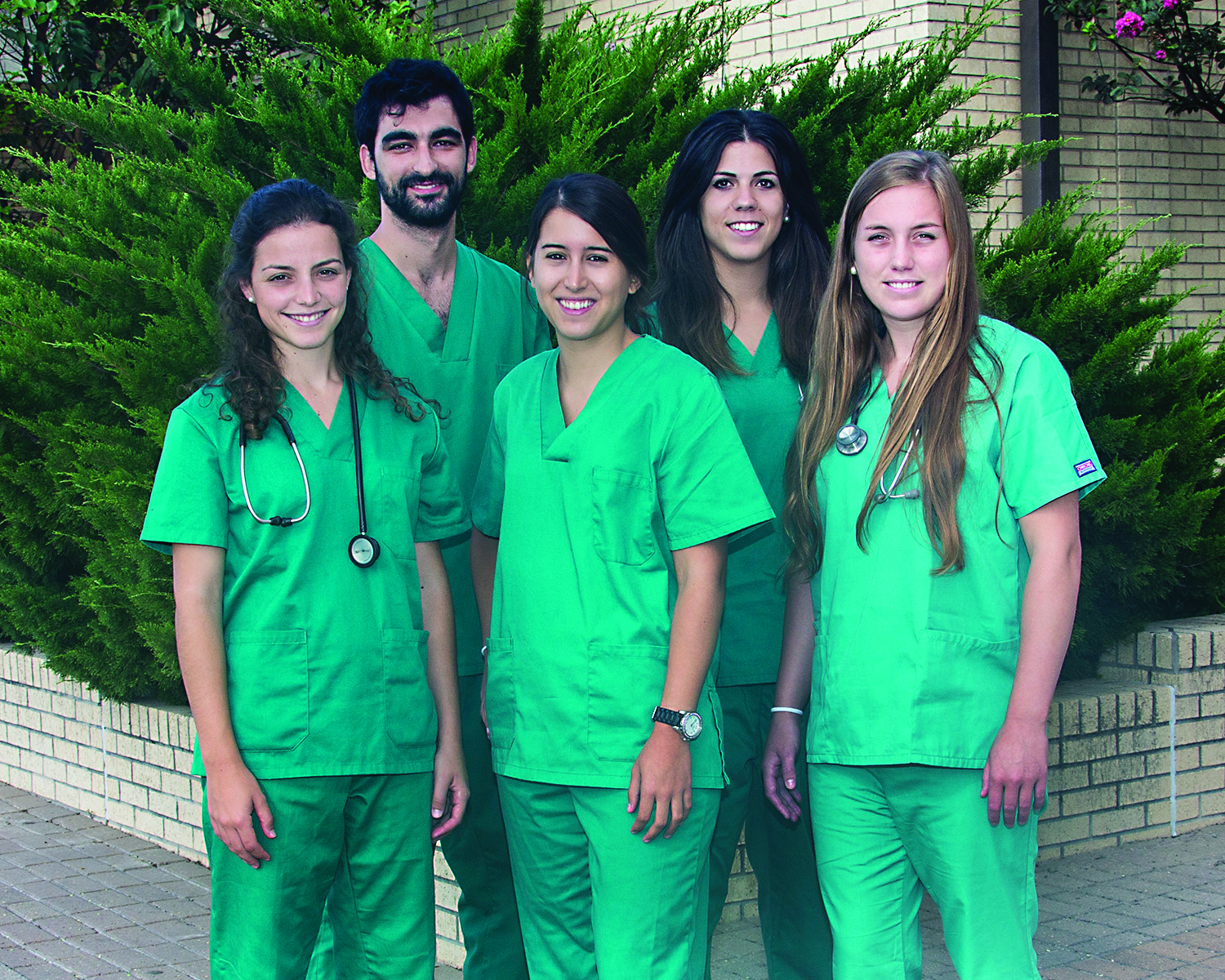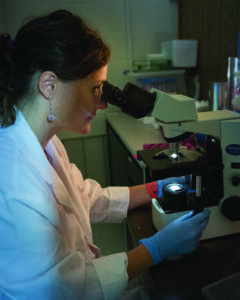Students from Barcelona Gain Valuable Experience at Texas A&M
Many students travel abroad for the chance to expand their knowledge and dive right into a new culture, language, and education system. Though all the Barcelona students agreed that these opportunities convinced them to study abroad at the Texas A&M; College of Veterinary Medicine & Biomedical Sciences (CVM), one of the biggest impacts on the students was something less deliberately planned: all-around personal growth.

One of the biggest leaps a student can take is making the decision to study in a foreign country. Whether the trip lasts three weeks or three months, studying abroad never fails to make a lasting impact on participating students. After researching several universities that offer study abroad programs through their veterinary schools, students such as Carla Carrera Gusart decided on Texas A&M; University because of the veterinary school’s strong reputation for success. Other students, like Silvia Cros Roura, considered an education at Texas A&M; to be her gateway to developing a diverse background in veterinary medicine. Each of these students independently came to College Station to study abroad and were here for variable times-some for a few weeks and some a few months.
“I wanted to go outside my country and practice. I wanted to see how veterinary medicine is organized in different countries, as well as how it is different,” Roura explained. “At first I wanted to go to Europe, but then I saw the program in the United States and thought, ‘Why not?'”
Though it was many students’ first study-abroad trip, María Simó Vesperinas is adding Texas A&M; to her list as her second country visited. After such a positive experience as an exchange student in France, Vesperinas decided to explore another culture. “My home university, Universitat Autònoma de Barcelona, offered me this chance, and I thought it would be a good option for me to improve my English and see other ways of working. They also told me that in the United States, you have more stuff to do with the animals. There is more money and more opportunity.”
While the students were expecting to experience culture shock, the difference in education systems came as more of a surprise. Roger Llaurado Perez was fascinated by the difference in education systems but was especially impressed with the hands-on experiences offered to fourth-year veterinary students. “What fourth-year students do here in the hospital on their rotations is what interns do in Spain,” he said. “Once you finish your studies in Spain, you apply for an internship, and if you get it, that’s when you do the stuff that fourth-year students do here. I think students from Texas A&M; are more prepared than students from Barcelona or Spain.”
While Perez appreciates the time students take on their studies before they obtain a veterinary degree, Gusart admires the communication between the students and the clients. “I’ve learned how important it is to get information from the client about the patient. In the hospital, all the students know how to get this information because they know how important it is,” she explained. “They always follow a case in the same way, first meeting with the client and then examining the patient. The process is different, we don’t do it the same in Spain.”
Roura added, “Here the students act like doctors before they finish the degree. I think it’s important because they gain more confidence in themselves. In Spain, we go out and might not feel as comfortable exercising as a veterinary doctor. The structure and planning of education is very important, and I think it’s good here.”
In describing their experiences working in the veterinary hospital, the students explained how the relationships between clinical personnel and veterinary students impacted them. They said professors were highly attentive to their needs, investing time in them if they did not understand the lesson material. The visiting scholars also admitted their astonishment at the care given to the general student population and were happy to feel included. “We felt more comfortable when we were working with them because we were treated like other students, and the students were treated like veterinarians,” said Gusart.
Though completing the paperwork and housing details might have been exhausting for the interns, the experience at the CVM was well worth it. Students were able to submit their preferences for working with large or small animals, making their rotations in the hospital more individualized and focused. Many of them even came out of the internship with special interests, naming several classes that they would recommend to other students. “I recommend taking pathology,” said Vesperinas. “I had a good time in there, and I learned a lot.”
The students were also exposed to new hands-on practices that they may not have been able to experience back home. Perez explored equine medicine, a field of study he recently became interested in. In fact, he cites this experience in the program as the most influential on his future career. “My main aim for coming here was to decide whether I wanted to practice in the small or large animal field, because just last year I realized that I like horse medicine,” he said. “This is actually my first time working with horses, and I enjoy it. Horses are possibly what I want to work on.” He added that Texas has also introduced him to western cultural traditions. “I have discovered the world behind horses, cowboys, and how much people care about their horses here.”

While each individual had a different journey during their time at the veterinary school, one transformation remains constant through each student: personal growth. Dr. Maria Esteve-Gassent, organizer of the exchange program and mentor of the visiting students, explained how each student faced and overcame challenges through the study abroad program. “I think what happens is your comfort zone expands,” she said. “When you’re used to a particular culture, or a particular language, you have this comfort zone. You think, ‘I have it under control.’ It’s predictable, everything is cool. As soon as you step out of that comfort zone, you’re afraid of things,” she continued. “You feel panic, and then all of a sudden, you feel like you’re comfortable there too. You’re not afraid of new things.
Besides organizing and coordinating the exchange program, Esteve-Gassent works to make sure each student feels comfortable in the new environment. Her counseling has helped the visiting scholars follow their passion in veterinary medicine and guide them through opportunities for individual development.
How did the exchange program between Texas A&M; and the faculty of Veterinary Medicine and Food Technology (a part of the Universitat Autònoma de Barcelona) start? Esteve-Gassent and other faculty began working to organize the program two years ago when pre-veterinary students from Texas A&M; became interested in studying abroad. Esteve-Gassent was able to make contact with the veterinary school in Barcelona through the pre-medical internship program in Spain that she also leads. “I just realized that this could be a great opportunity not only for the pre-veterinary students, but also for the veterinary students when they’re interested in studying abroad or some type of internship somewhere else,” she explained. “Very few people think about Spain, I guess because it’s farther away. It’s a relatively safe environment, and I thought it would be a great opportunity. Now I’m their point of contact.”
Esteve-Gassent’s inspiration to begin international programs came from her experiences as a graduate student in Spain. After studying for a year in Denmark, Esteve-Gassent developed an understanding of other cultures and was introduced to new perspectives. “You get this understanding of other cultures, and I like the fact that you can pick and choose. When you know about other cultures and how people do things in other places, you can say, ‘Hey, I like it better. Why shouldn’t I do it this way too?'” explained Esteve-Gassent. “There might be things in life that make you say, ‘I don’t like it, but I understand where it comes from.”
Esteve-Gassent’s experiences studying abroad impacted her so deeply she was moved to share this opportunity with her students at Texas A&M; years later. “Since I’m a Spaniard, I wanted to have Spanish students experience the same personal growth and international awareness I did,” she said. “That is what my goal is, even when I teach undergraduates.”
Now, after working hard to coordinate and organize the finest details, Esteve-Gassent is proud to announce that Texas A&M; will complete a full exchange with Barcelona in the near future, sending a maximum of five professional and undergraduate students per year to Spain. Each exchange student in Barcelona and Texas A&M; will visit the other campus for four to 12 weeks, with a goal of completing several full hospital rotations.
Although the Barcelona students all had different journeys during their time at Texas A&M;, they all shared a personal growth experience. While studying abroad can be invaluable, no one can truly estimate how positive international programs can be until they experience it for themselves. Though there is extensive planning and paperwork involved in studying abroad, faculty such as Esteve-Gassent work to communicate the importance of cultural understanding and awareness through international programs. “I hope to keep doing this for a long time, so we can impact more students’ lives,” she said.


